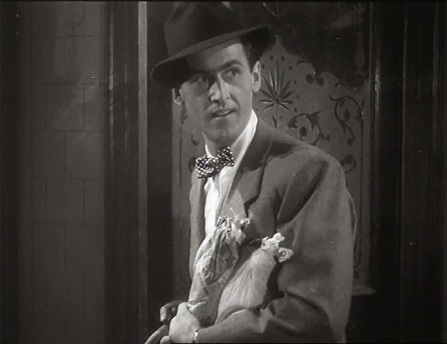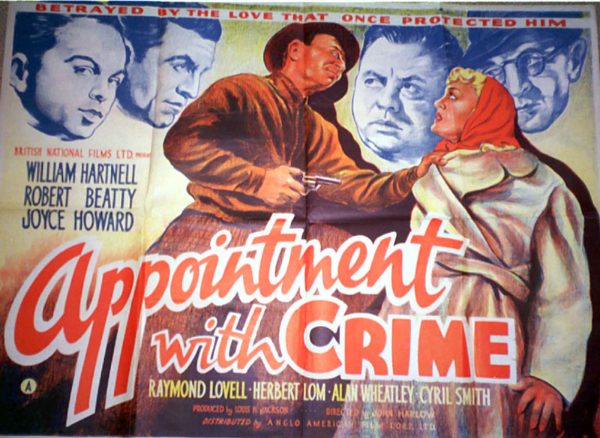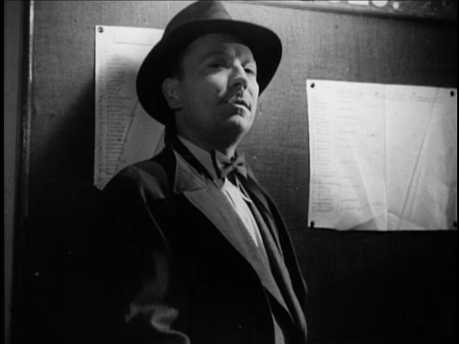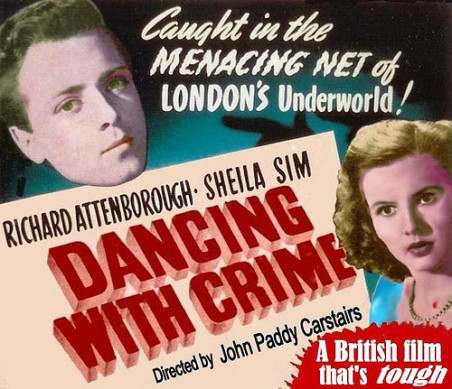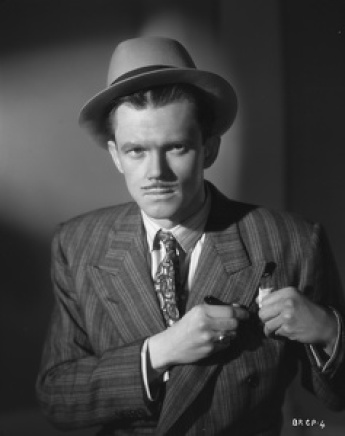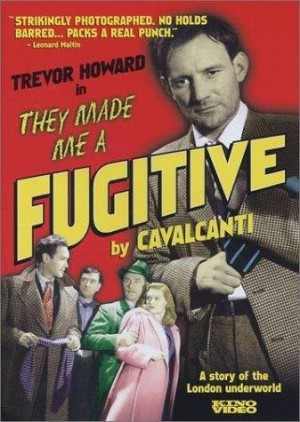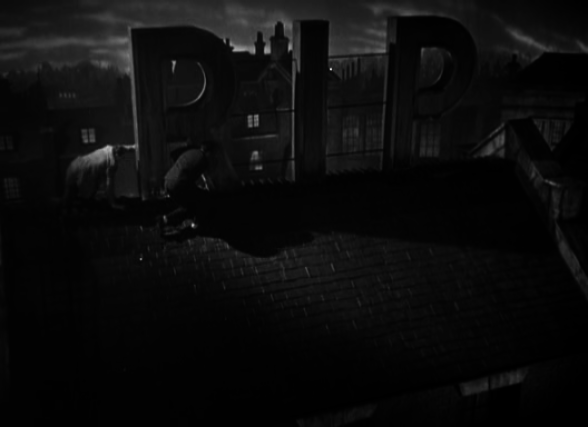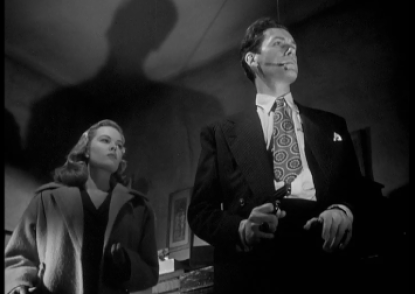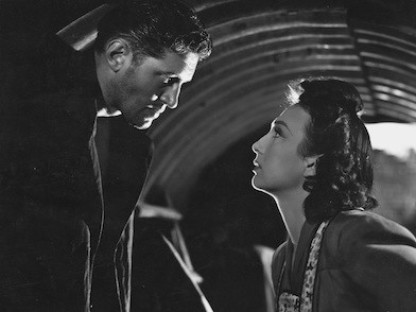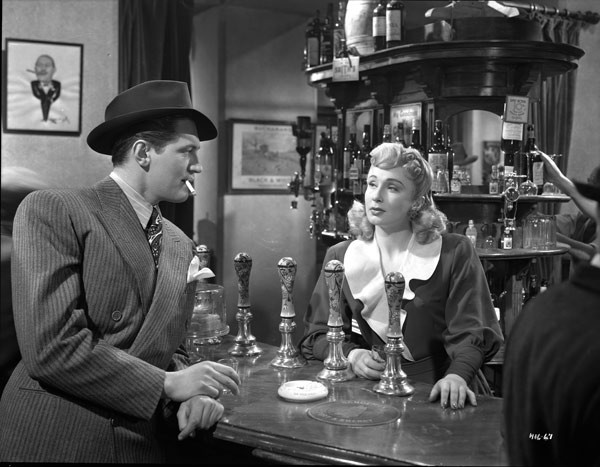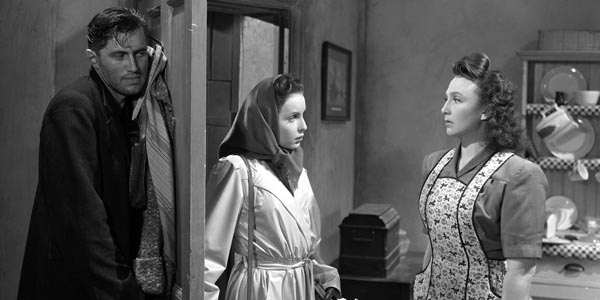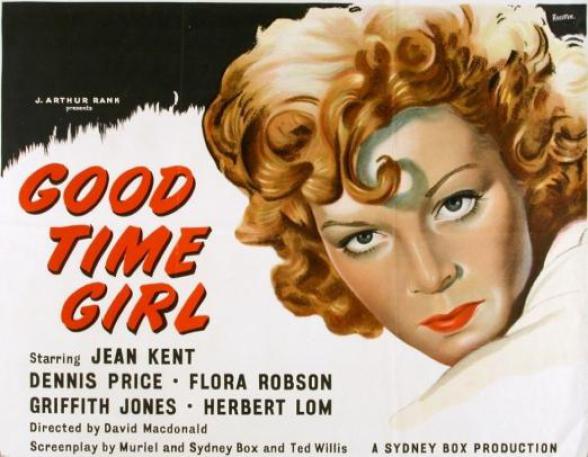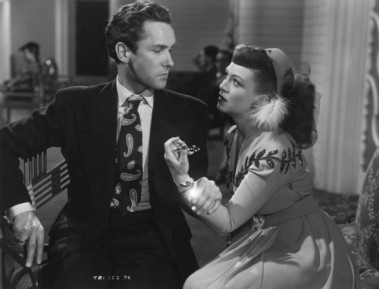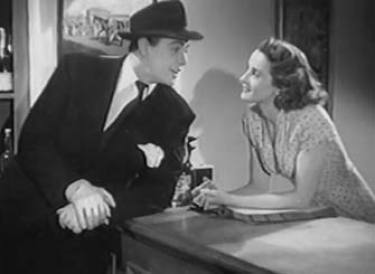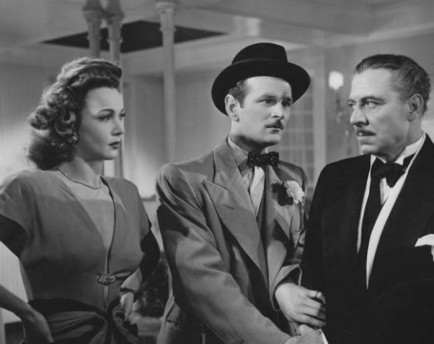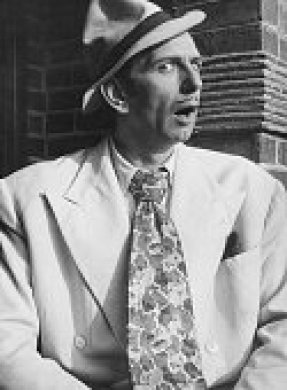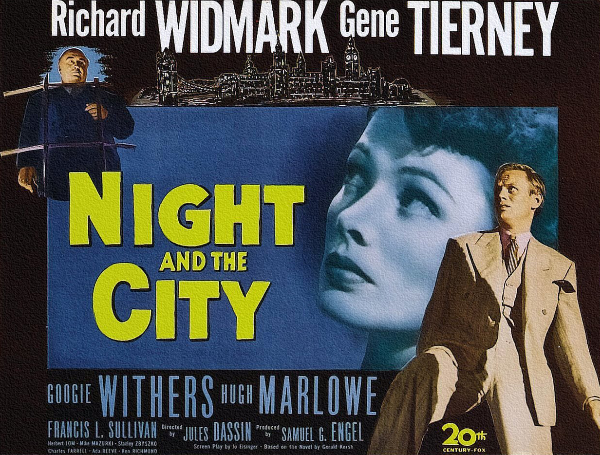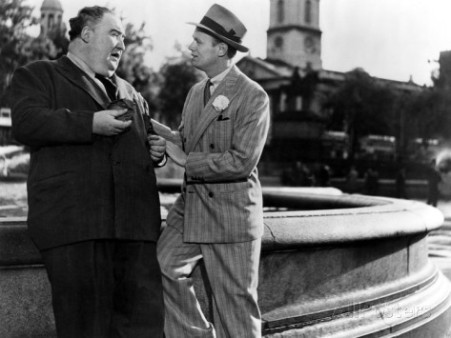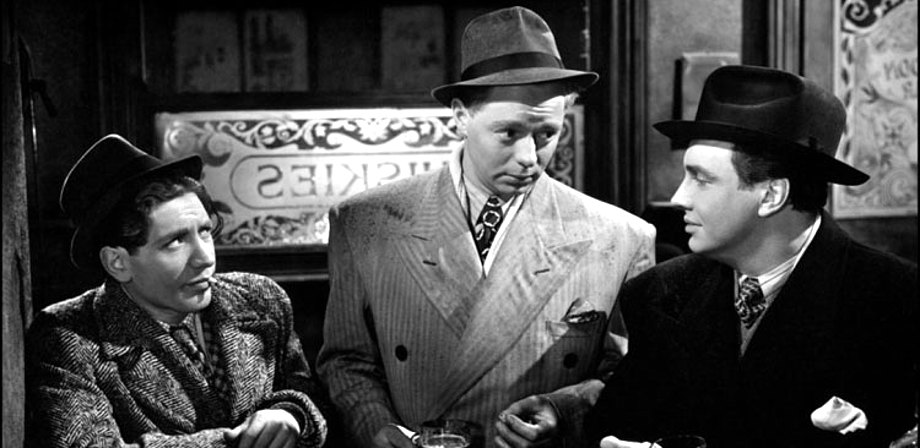
THE 1940s' SPIV CYCLE
When one hears the word 'spiv' the people above may be some of the people that spring to mind; George Cole as Flash Harry in the St Trinian's films is probably the most famous, and of course he based the character of Arthur Daley on this previous incarnation.
The term 'spiv' has unknown antecedents - at least they are disputed - but there is general consensus that there were a number of films, seemingly unrelated, that came out from about 1946 through to about 1950, known as the 'spiv cycle' of films. The generally accepted first appearance of a spiv is that of Stewart Granger's character Ted Purvis in Waterloo Road (1945), complete with bow-tie signifier (see above). Purvis is a ducker and diver, who has escaped war service through getting a phony exemption certificate from a doctor (a common scam during the war to avoid the call-up) as Jean Kent explains to John Mills in this clip as Mills looks for his wife Tillie, who has been swept off her feet by Purvis:
Appointment with Crime (1946)
It was not until the release of Appointment with Crime in late 1946 that the films started to seep into public conciousness. This film, starring William Hartnell, later to find fame late in his career as TV's 1st Doctor Who, was a tough (by British standards) crime melodrama. Here is the opening scene, where Leo Martin, played by Hartnell. feels betrayed and seeks revenge after he is sent to prison:
This film has the first use I can find of the term 'spiv' itself; Martin refers to himself as one, in an exchange with dogged copper Det Insp Rogers (Robert Beatty); when Rogers questions why Martin thinks he (Rogers) should think he has killed Loman, Martin replies:
Because you're a copper and I'm a spiv!
and later in the film Rogers' Sgt also uses the term; when pondering who has stolen a handbag he suggests "Oh, some spiv".
But Martin is really just a career criminal, and his main connection with TYed Purvis and the standard image of a spiv is, again, his bow tie which he sports throughout most of the film.
Dancing with Crime (1947)
This was quickly followed by Black Memory, with Michael Medwin as a proto-spiv, and Dancing with Crime (see poster right), which despite its claim to be 'A British film that's tough' is rather softer than Appointment.... This of course was the period when American film noirs and crime films were at their peak, and the British films are overall much tamer than their US counterparts, possibly due to censorship. The main 'spiv' in this film is the then-named Bill Rowbotham (better known to us all now as Bill Owen) whose character, Dave Robinson, is a friend of Ted Peters (Richard Attenborough) from their war days. Dave is now a cheery, hail-fellow-well-met geezer who is making easy money having been drawn into the criminal underworld, and tries to do Ted a 'favour' by cutting him in, but Ted is straight as a ruler and politely rejects Dave's entreaties. When Dave is killed early on by other members of the gang, Ted seeks justice, but the film lacks the realism of later films and the gang, as led by Barry Evans, has the feel of a 30s 'jewels robbery' mob where a sock on the jaw is usually enought to settle matters. This s the sequence where Dave tries to persuade Ted to come in with him, dealing in "this and that - everything a rich man wants and can't get":
Brighton Rock (1947)
Attenborough however went on to play what is surely even now still his most famous role; Pinkie, the teen gangster in Graham Greene's Brighton Rock. This was a role that, along with the lesser-known They made me a Fugitive, really put British crime films and the spiv firmly on the map. The reviews were mixed, although they all focused on the film as part of the crime or spiv cycle of films (see left for example, where Joan Lester in Reynolds News calls it a "serious analysis of spivery" and praises it for delamourising crime and criminals). Reg Whitley in The Daily Mirror however was virulently opposed to the film, calling it "cheap, nasty sensationalism" which prompted Greene to seek a published reply the next day.
Adapted from Greene's novel published in 1938, with a script by him and Terence Rattigan, the film takes care to place the film pre-war, the opening credits heavily implying that all the sordidness and violence of those times is now but a distant memory (apart from anything, the studio had to keep Brighton council onside) as the opening scene shows, ending with the visual introduction of one of the screen's most terrifying villains, Pinkie:
Again, though, this is really a crime movie, with its protagonists clearly members of a criminal underworld with very liitle or no interaction with the general public (one of the key defining elements of spivvery) and its distance from the world of rationing and black markets is increased by it being specifically set in the pre-war world.
The only character who even remotely relates to this world is Cubitt (Nigel Stock) who lacks the bow tie but has the other key signifier of a spiv, a pencil moustache, and dresses accordingly, with a brash striped suit and a jaunty hat tilted back, none of which is mentioned in the book. He has a limited role in the film however, and one of his key scenes in the book, where he goes to see Colleoni at the Cosmopolitan hotel and ends up talking with Ida Arnold, is omitted from the film version.
The cinematography and sets owe more to film noir, at its peak at this time in the US with films such as Build My Gallows High and The Killers having just been released. The sequence below (actually two scenes spliced together) has some wonderful lighting effects in the doss house, very reminiscent of German expressionist lighting in films such as The Cabinet of Doctor Caligari.
They Made Me a Fugitive (1947)
They made me a Fugitive, directed by the Brazalian Cavalcanti (who had done a great deal of good work with Ealing) attracted quite a lot of criticism, par for the course with these kinds of films. This was at a time when British cinema was trying to establish a reputation for 'quality' cinema; literary adaptations (Lean's Great Expectations and Oliver Twist were made in 1946 and 1948 respectively) were top of the agenda, for example, and for some journalists and critics the crime/spiv films were dragging everyone back into the gutter. Arthur Vesselo, writing in 'Sight and Sound', called it "a tale of sordidness, corruption and violence almost unrelieved".
This however is why I like these films, along with Gainsborough melodramas, and the Eric Portman/James Mason 'morbid burrowing' films of the late 40s, they offer an alternative (and much more modern) view of the world to that of Ealing and the 'quality' films, many of which are now long forgotten.
The film actually marketed itself as a spiv film, as this image (right) of the film's pressbook shows, with the legend 'They Made Me a Spiv!' leaving the reviewers in no doubt as to the audience that was being targeted.
They made me a Fugitive (known as I Became a Criminal in the US) was adapted from a book called 'A Convict has Escaped' (and therefore sometimes confused with another little-seen spiv film called A Gunman has Escaped); the strange thing is that it only takes one scene from the book and changes everything else (in the book, which seems to be set pre-war, the main character is South African and the plot is completely different). The film follows the fortunes of Clem Morgan (Trevor Howard), an ex-serviceman who is looking for some excitement now that the war is over. He meets up with Narcy (Griffith Jones), who runs a smuggling ring using an undertaker's business as a front. The following scene shows, firstly, that Clem had 'a good war' and is simply bored with life on civvy street, whilst Narcy is obviously somebody who knows where to get hold of goods, genuine or counterfeit:
Clem soon finds that, along wtih nylons and booze, Narcy's gang also smuggle drugs, especially "sherbet" (the only acceptable term for cocaine at the time), and decides to get out, but he hasn't reckoned on Narcy, who doesn't allow anyone to leave so easily. Setting Clem up during a job, he and Clem, along with Soapy, one of the gang, attempt to get away but kill a police officer as they make their getaway, and they leave Clem to take the blame. Sentenced to 15 years, he is visited in prison by Sally (Sally Grey) who admits that she was Narcy's girl but she has been thrown over for Clem's Ellie, whom Narcy had designs on right from the start.
Morgan manages to escape from prison and heads back to London, his only chance being to prove his innocence by getting Soapy to admit that Narcy framed him, helped by Sally; whilst Inspector Rockliffe (Ballard Berkeley, most famous for playing the Major in Fawlty Towers 30 years later) tries to track him down.
There are some wonderful dark shadows (see the shot of the roof of the funeral directors, above) and the film is possibly the one that most approximates to the American noirs, in particular a sort of sub-genre of 'man on the run' pictures. The film was particularly criticised for its mood and for its brutaltiy, which may mean little now, but at the time it caused quite a stir. This sequence (two separate scenes spliced together to give a flow to the story) shows the air of meance that Narcy is able to convey, and Soapy's fate is as dispiriting and bleak as one could wish for:
It Always Rains on Sunday (1947)
Speaking of which, It Always Rains on Sunday features John McCallum as Tommy, on the run from prison and hiding out with his old lover, Rose (Googie Withers, his real-life wife) in Bethnal Green. This film, adapted from an Arthur la Bern novel, attracted positive and negative reviews at the time; interestingly, Arthur Vesselo, quoted above, defended the film:
"It is a film with vitality, humour and more than a gleam of atmospheric magic, as well as back-street squalor; and only the hasty will deny the naturalism of much of its visual and spoken language"
With its tag line of 'The Secrets of a street you know', here's a trailer with an extremely portentous voiceover, poor sound quality but still thanks to junkiefix for uploading it:
What makes It Always Rains on Sunday so successful, and was much commented on at the time, is its depiction, as set out in la Bern's novel, of a vibrant East End community, with a wide panorama of characters, including three small-time crooks (see picutre at the top of the page, with Alfie Bass, Jimmy Hanley and John Carol) who steal a load of kids' roller skates and then have to get rid of them, through the two Jewish brothers Lou (John Slater) and Morrie (Sydney Tafler) Hyams (see below), their father and sister, the landlady of a run down doss house, played by Hermione Baddeley, through shop keepers and pie stall owners, the local pub and of course the police.
Much of the buying and selling, and the general hubbub of life on the streets, in the pubs, the markets and the arcades and youth clubs, has little or nothing to do with the main plot line of Tommy Swann's relationship with Rose and his attempt to get away, and it is this background that makes it arguably the most succesful 'spiv' film in its portrayal of the interlinked networks necessary for racketeering and black marketing, with its associated criminality to take place. This extended sequence - basically a string of five different clips - demonstrates this as a tale of stolen roller skates being fenced draws together three local chancers - Whitey, Dicey Perkins and Freddie - along with brothers Morry and Lou Hyams, local fence Beesley and Inspector Fothergill (Jack Warner).
Good Time Girl (1948)
Good Time Girl, adapted from another Arthur la Bern novel (Night Darkens the Street), is not so celebrated as IAROS, possibly because it soon turns into melodrama and possibly because its claim to realism is somewhat spoilt as its main character, Gwen Rawlings, is supposed to be 16, passes herself off as 19, but is played by Jean Kent, who in fact was 25-26 at the time!
I must admit I laughed out loud when I saw the shady character (Jimmy Russo) played by Peter Glenville appear. He even has the classic spiv pencil moustache! See for yourselves, in this clip starting with Jean Kent taking lodgings after she leaves home:
Griffith Jones (Narcy in TMMAF) reappears as Danny Martin, one of the many undesirable characters that Jean Kent meets on her travels in the underworld, who is first seen talking nylons and whiskey with Herbert Lom, thereby establishing his spiv credentials. Danny and Gwen (now known as Millie Carstairs) soon become a couple, but she becomes jittery as his criminal activities become more prevalent, and she decides to leave him - but it proves not to be so easy, as this clip shows:
It's a good film, which reminds me a bit of Jenny Maple's story in Patrick Hamilton's 'Twenty Thousand Streets under the Sky', but it's spolit a bit by the story being told as a cautionary tale by Flora Robson to a very young Diana Dors at the start and end of the film, but this is par for the course in the censor-conscious and moralistic 40s.
Night Beat (1948)
Nightbeat (1948) is a rather forgotten film now (although it's just been released on DVD in 2015) but not only does it feature another spiv-like character in Felix Fenton (Maxwell Reed, sometimes described as 'the poor man's Stewart Granger', so perhaps it is appripriate that he is playing another version on the Ted Purvis template) but it is also a key film in another sub-genre first formally identified by Brian MacFarlane, that of the 'post-war readjustment' film. Ronald Howard and Don Brady play Andy Kendall and Don Brady respectively, two mates just of the army (Commandos) and kicking about for something to do. They meet up with Don's girl (and Andy's sister) Julie (Anne Crawford) and through her meet up with Felix Fenton, another one who got out of doing the fighting and did rather well for himself in the meantime, running a nightclub, much to Don's disgust, as this scene shows:
Felix is not really so bad, and overall cuts a reasoanbly sympathetic figure, although inevitably he has his fingers in a few pies, and Andy soon finds himself - quite willingly, it has to be said - involved in smuggling goods whilst working for Felix and getting sent down for it, alhtough he escapes with a suspended sentence. Most reviews focus on the particularly dull and wooden performance of Hector Ross as Don, but Reed himself (who I personally have always regarded as one of the stalwarts of this type of film, verging on the B movie, see his roles in films such as Daybreak, Dear Murderer, Marilyn etc) does well with a rather more complex character than usually appears in this sort of crime melodrama.
Noose (1948)
Robert Murphy's book 'Realism and Tinsel: Cinema and Society in Britain 1939-1949' says that there were 4-5 more spiv films in 1948 - Night Beat, The Flamingo Affair, A Gunman has Escaped and Noose (possibly London Belongs to Me) - but I can't get hold of the middle two, and Night Beat is discussed above.
When I did a course on post-war British cinema at the UEA in Norwich a few years ago, we had a week where we had to pick a British post-war film and pick a theme from it and talk about it, with clips, for about 15 minutes. I chose Noose. This is partly comedy, partly very serious, wtih Nigel Patrick playing Bar Norman, already almost parodying a spiv. This opening sequence shows him as a hail-fellow-well-met friend of the world, complete with carnation in his lapel, but his business ins't quite legit, as we see with forger Slush (Edward Rigby) - "Blimey, you got a watermark n'all!"
Joseph Calleia, a Maltese-born Hollywood actor, plays Sugiani, who I think is a genuinely scary thug. Ridiculous as it sounds, I wondered if it was Harry H Corbett playing the part when I first saw it! Known to his associates as 'Knucksie' - due to his propensity to use knuckdedusters - he plays the hard man to Gorman's nice guy in this scene, where they visit Linda Medbury (Carole Landis) who has taken it upon herself to try and expiose Sugiani's activities in her newspaper (although she is a fashion correspondent, not a crime reporter, which probably explains the range of silly hats she wears throughout the film):
Bar Gorman was a semi-comic spiv, and the character was already branching out into other types of entertainment, such as Arthur English's stage character (left) and in Osbert Lancaster's carttoons. one of the famous Ealing comedies, Passport to Pimlico, which became one of three such films released in 1949 (along with Whiskey Galore! and Kind Hearts and Coronets), was 'Dedicated to the memory of' before an image of clothing coupons and ration books, and plays on the desire to live in a world free from petty restraints and regulations.
Finding that their borough of Pimlico is technically part of Burgundy due to an old treaty, which has never been annulled, the residents realise that they no longer have to comply with all the government restrictions and rationing. However, everyone else also realises the implications, and the next morning they find that they are overrun with every possible racketeer, chancer, and on-the-make geezer possible - as one character puts it, a "spivs' paradise":
Night and the City (1950)
The cycle seemed to come to an end with Night and the City, a British film set in London but one with an American director, and two American stars. Richard Widmark plays Harry Fabian, a typical Del-boy of his time, ducking and diving, but it is obvious to everyone, including the audience, that his grand schemes will come to nothing.
However a great opportunity comes his way in the form of Gregorious, a famous wrestler, whom Fabian plans on promoting. The problem is that Gregorious' son is a local gangster, played by Herbert Lom (supposedly Greek here, sometimes Maltese in another film, also an Italian in others; in fact he was Czech).
There is a great deal to be said about Night and the City, but having just finished Kersh's novel I've written about both in the book-to-film adaptations section. I'll end with comments from Robert Murphy:
"As the black market shrank, relations between criminals and the public were once again reduced to a minimum and the underworld became more deeply shrouded in obscurity. The spiv became a figure of fun - George Cole's Flash Harry in the St Trinians films - and British crime films sank back into the netherworld of the second feature."




